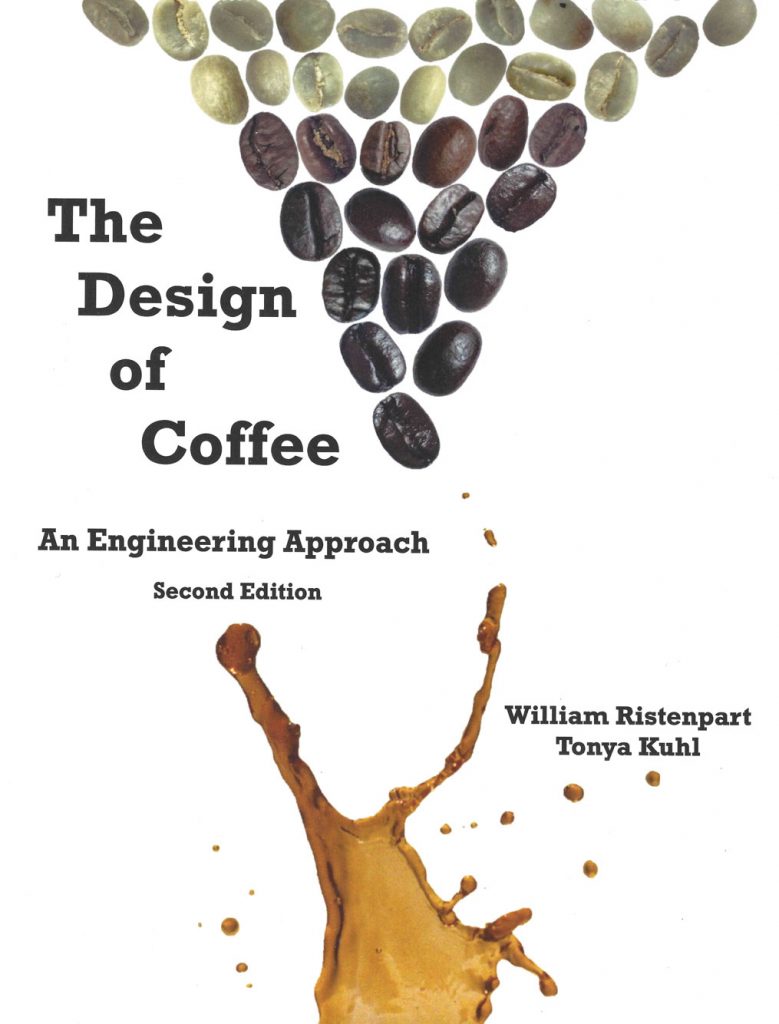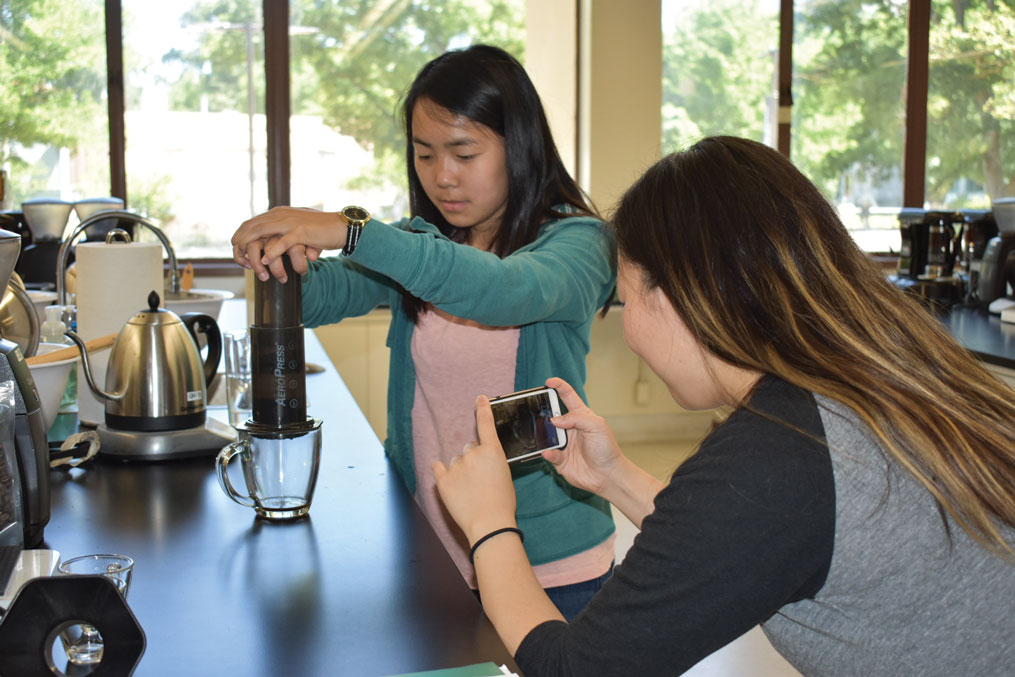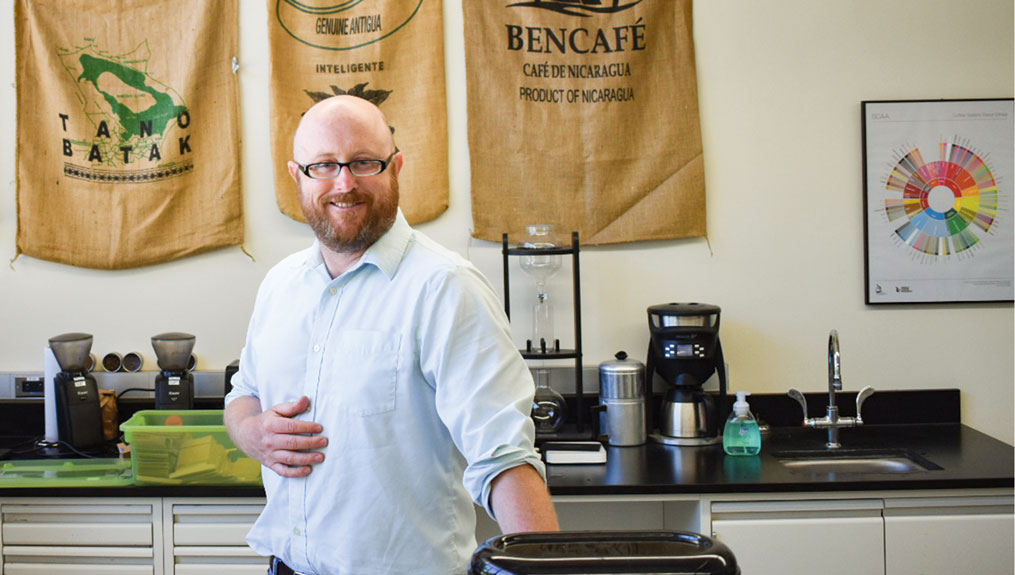Ristenpart inside the UC Davis coffee lab. Photos by Dan Shryock.
PROFESSOR AT UC DAVIS COFFEE CENTER
William Ristenpart is becoming a celebrity of sorts in the coffee world. A chemical engineering professor at the University of California, Davis, he heads up the UC Davis Coffee Center research facility. He’s a frequent speaker at conferences around the world and most recently appeared with his colleagues on a CBS News report about coffee research.
To thousands of college students, however, he’s the instructor who helped open their eyes to chemical engineering via the coffee bean. He teaches one of the most popular classes on campus. And, it all started with a bright idea over his own cup of coffee.
Professor Ristenpart talked with Fresh Cup in February about the Coffee Center, its research, and the class that started it all.
This interview has been edited for length.
Fresh Cup: Please go back to the beginning. What was the genesis of coffee research at UC Davis?
William Ristenpart: Sometime around 2012, my colleague, Professor Tonya Kuhl, and I were thinking about how we could improve our upper-division chemical engineering laboratory courses and she proposed, “Hey, why don’t we have them reverse engineer a Mr. Coffee drip brewer?” The idea was to take one of those apart and have the students figure out how it works because it’s actually more complicated than most people appreciate.
We were drinking a cup of coffee in the hallway and when she said that, I had a light bulb go on in my head. I thought we could make an introductory course and open it up to everybody on campus because the big insight is that the whole process of turning a green coffee bean into a cup of coffee involves basically everything we talk about in the entire chemical engineering curriculum. We can map that process of roasting, grinding, and brewing a cup of coffee.
We rolled it out as a freshman seminar in 2013 to 18 students and the feedback was very positive, so we rolled it out as a regular course and now we’re up to about 2,000 students a year.
FC: What is this course and what is the focus?

WR: I’m actually standing in the classroom right now. The class is called “The Design of Coffee” and the goal of the class is to provide a non-mathematical introduction to science and engineering principles using coffee as a working example.
The undergraduate lab in the center of campus is a teaching lab. It’s an introductory course, so it’s designed for high throughput, lots of students doing simple introductory experiments to teach them about science and engineering using coffee. In contrast, the Coffee Center building over on the other side of campus is for much more advanced, cutting-edge research with graduate students doing their master’s and PhD work on coffee. So, we have both sides of the coin here.
[The Coffee Center building] was built about 10 years ago for a different purpose. We’re already making use of two-thirds of the space with some temporary renovations. We have some small roasters and a small brewing lab already set up. We’ve been fundraising philanthropic support to renovate this building because we have a tremendous opportunity to make something really amazing for the coffee industry.
Something I’m really excited about is setting up a sensory descriptive lab with booths and lights and all that.
FC: Can you explain how a sensory descriptive lab operates?
WR: Descriptive analysis? It’s all about what coffee tastes like. We use sensory description isolation booths. Typically, you can’t see the product and you’re in isolation, so you don’t see other people. You only smell the product that’s in front of you. The idea is that you taste a product under carefully controlled conditions and then you give quantitative information about how it’s different.
FC: Where else is the research taking you?
WR: The thing about coffee is how complicated it is. I have a lot of colleagues here at Davis who study wine and they know better than anybody how difficult it is to make a good glass of wine. And it’s even more challenging, more complicated to make a good cup of coffee. That complexity is invisible to most people because it’s behind the scenes but when you think about the overall process of taking the seeds of the coffee plant and turning them into a cup of coffee, there are way more unit operations, there’s more steps.
Typically, there’s an international divide and a language divide and most importantly the science is very unsettled. What controls the differences in taste between a [washed] coffee and a natural process coffee? We know there’s a flavor difference but what’s the actual chemistry? What’s the microbiology? Nobody really knows so you take all those unanswered questions and the increased complexity along the supply chain, so I think you make a very strong case that coffee is actually a much more complicated beverage.
FC: I’m holding a cup of coffee in my hand right now. How does all this research relate to what I’m drinking?
WR: That’s a great question. One of our goals is to help improve quality of coffee around the world. Hopefully you’re enjoying your cup of coffee, right? It’s not an accident that you have a good cup of coffee in your hand. A lot of work went into that. In one sense, our goal at the Coffee Center is to help disseminate and educate the public about how much work goes into that.

On a more important scale, people here in the States see the barista and they might see the roaster but what they don’t necessarily realize is that there’s about 100 million people around the world whose livelihoods depend on growing and picking coffee. There are a lot of people in developing countries that if demand for coffee dried up, they would not be doing so well. So, anything we can do to improve our understanding of coffee, the sustainability of coffee, the quality of coffee to drive up demand actually affects a huge number of people around the world.
FC: Is the Coffee Center looking at the effects of climate change on coffee crops?
WR: Absolutely. One of the things that I’m very excited about is that the UC Davis Coffee Center has forged a collaboration with World Coffee Research. World Coffee Research several years ago started an international multi-locational variety trial. That’s a fancy way of saying that they took about 20 different cultivars of coffee and planted them each in 20 different locations around the world.
The reason they did that is because there’s an astonishing lack of information. A very simple question is what type of coffee does best in a hot environment. It’s a simple question but there’s no good data out there on that. So, they’re doing research on that genetic versus environmental interaction to try to answer the question, specifically in the face of climate change.
The Coffee Center comes in because World Coffee Research is so dispersed around the world, they didn’t actually have a central place to curate, to collect all the samples and then do chemical and sensory analysis on them. The Coffee Center is playing that role. We’re starting to receive samples of these different cultivars grown in these different locations around the world. Soon we will be working to roast them and then do chemical and sensory analysis.
FC: Building a research laboratory like the Coffee Center takes money. Several major sponsors are listed on your website. How is fundraising progressing?
WR: We welcome philanthropic support at any level, but the reality is that to renovate a building on a university campus anywhere in the country is very expensive. This is the reality. Fortunately, we’ve had some very generous partners including many that are listed there. We just announced a gift from Toddy, which manufacturers cold brew coffee equipment, so they are funding one of the rooms. It’s going to be the Toddy Innovation Lab, space designed for cold brew experiments and advanced flexible space for different tests on brewing techniques or roasting techniques or whatever.

FC: Did you ever expect you’d get to this point?
WR: No, not at all. When I first got into coffee, I thought it was just going to be a fun way to teach students about science and engineering, but what my colleagues and I quickly realized was that there was a huge unmet need for science, academic validation, and advanced education in the world of coffee. What I thought of as just a fun class has really blossomed into something even bigger and better. And I’m very excited about it.
I’ve worked on a lot of different kinds of engineering problems in different fields and coffee, I think, is by far the one that engenders the most interest amongst both the public and the coffee industry. We just hosted the Specialty Coffee Association’s Sensory Summit here at UC Davis, and it’s amazing to me that people take time out of their busy schedules to come to UC Davis and learn about the science. The people are fascinated by it and, as an academic, that’s where you want to be.















